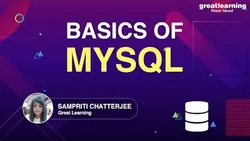
MySQL Tutorial for Beginners Introduction to MySQL Great Learning 
This tutorial provides an introduction to MySQL, a popular database management system. It covers the basics of MySQL, including its features and how to use it to store and manage data. It is designed to help beginners understand the fundamentals of MySQL and how to use it effectively. ▼
ADVERTISEMENT
Course Feature
![]() Cost:
Cost:
Free
![]() Provider:
Provider:
Youtube
![]() Certificate:
Certificate:
Paid Certification
![]() Language:
Language:
English
![]() Start Date:
Start Date:
On-Demand
Course Overview
❗The content presented here is sourced directly from Youtube platform. For comprehensive course details, including enrollment information, simply click on the 'Go to class' link on our website.
Updated in [February 21st, 2023]
Today, we have data present everywhere around us in the form of text, bills, photos, videos etc. Hence, It's management has become really important. Today, we'll be discussing the basics of MySQL and we will be guiding you through the basic concepts of MySQL which will help you manage this immense data.
SQL is known as Structured Query Language. SQL is the standard language for storing, manipulating and retrieving the data in databases. We will be covering the basics of SQL through various examples. A database usually contains one or more tables and we apply different functionalities on the records of this database. We apply SQL commands or Queries on this database.
In this tutorial, we will be teaching about data manipulation, it's extraction and fetching. Through this example, we will teach you how to update, read, create, delete data in a database. We will use different techniques such as Joins and we will learn to use various other SQL functions as well. So, stay tuned and watch the video till the end.
(Please note that we obtained the following content based on information that users may want to know, such as skills, applicable scenarios, future development, etc., combined with AI tools, and have been manually reviewed)
This course provides an introduction to MySQL, a Structured Query Language used for managing and manipulating data in databases. It covers the basics of SQL, data manipulation, extraction, and fetching, as well as techniques such as Joins and other SQL functions.
Possible Development Paths: Learners of this course can develop their skills further by taking more advanced courses in SQL, such as learning to create databases, use SQL for web development, and use SQL for data analysis. They can also explore other database management systems such as Oracle, PostgreSQL, and MongoDB.
Learning Suggestions: Learners can supplement their learning by exploring related topics such as database design, data modeling, and data warehousing. They can also practice their skills by working on projects such as creating a database for a website or analyzing data sets. Additionally, they can read up on the latest trends in database management and data science.
[Applications]
This MySQL Tutorial for Beginners Introduction to MySQL Great Learning course provides a comprehensive introduction to the basics of MySQL. It covers topics such as data manipulation, extraction, and fetching, as well as techniques such as joins and the use of various SQL functions. After completing this course, learners should be able to apply the concepts learned to manage data in a database, update, read, create, and delete data, and use SQL commands and queries.
[Career Paths]
1. Database Administrator: Database Administrators are responsible for the installation, configuration, upgrade, and maintenance of databases. They also monitor the performance of databases and ensure that they are secure and running optimally. As the demand for data storage and analysis increases, the need for Database Administrators is expected to grow.
2. Database Developer: Database Developers are responsible for designing, developing, and testing databases. They create database structures, write queries, and develop applications that interact with databases. With the increasing demand for data-driven applications, the need for Database Developers is expected to grow.
3. Data Analyst: Data Analysts are responsible for analyzing data and extracting insights from it. They use various tools and techniques to analyze data and develop reports and visualizations. As the demand for data-driven decision making increases, the need for Data Analysts is expected to grow.
4. Data Scientist: Data Scientists are responsible for analyzing large amounts of data and extracting insights from it. They use various tools and techniques to analyze data and develop predictive models. With the increasing demand for data-driven decision making, the need for Data Scientists is expected to grow.
Course Provider

Provider Youtube's Stats at AZClass
Discussion and Reviews
0.0 (Based on 0 reviews)
Explore Similar Online Courses

Email Productivity: Work Smarter with Your Inbox

Brand Marketing: Planning A Successful Event

RDBMS PostgreSQL

Intro To PostgreSQL Databases With PgAdmin For Beginners

PostgreSQL: Client Applications

Mastering SQL using Postgresql

Database Design and Basic SQL in PostgreSQL

PostgreSQL: Advanced Queries

Spatial SQL with Postgres : A language for geographers

Learn SQL Using PostgreSQL: From Zero to Hero

PostgreSQL Essential Training


Start your review of MySQL Tutorial for Beginners Introduction to MySQL Great Learning